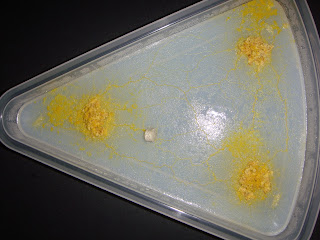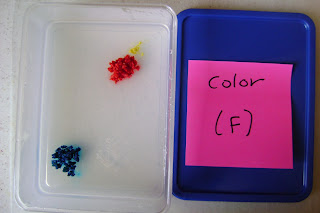pRO BOno
Allyn Polancic and Hector Ruvalcaba, Fall 2010 Robotics, Professor Michael Fox, Cal Poly Pomona
Wednesday, December 7, 2011
Module Adaptation
We are now trying to adapt the mold to a new container - a hexagonal module that will make up a wall displaying all the projects of the class. We have had much difficulty growing the mold in the larger container mostly because it does not retain moisture. Previously, the mold was grown in smaller airtight tupperware containers. It had also escaped some containers and grew onto a sheet of nearby bubble wrap. However, those conditions must have had just the right amount of humidity. Now that we have learned that the mold will not simply grow on bubble wrap in any conditions, we are frequently misting inside the module and storing it in a plastic bag. The mold is now growing better under these conditions, but prefers to grow on a moist paper towel inside the module instead of the bubble wrap.
We needed to place chunks of agar inside the module to get the mold growth started. Smaller pieces of agar and mold that were previously placed in the bubbles (at right) had dried and shriveled.
Mold is growing underneath the bubble wrap onto the moist paper towel.
We are testing several experiments to find out how to make the mold grow at this larger scale. The first involves injecting agar solution into the bubbles across the sheet to both maintain humidity levels and give the mold more of its preferred growing medium.
Another experiment involves using the agar alone as the growing medium and using the bubble wrap as a simple mold for the agar. This way, the mold can grow on its preferred surface and the result will still incorporate the texture of the bubble wrap.
Results to come.
Monday, November 28, 2011
Day 7 Progress
The following 3 experiments were 'mock' robotic scenarios carried out over the past 7 days. Our purpose was to investigate what causes the mold to change its growth patterns. How can we control the movement of the mold?
First we conducted a Directional test. The mold was placed at one end of a horizontal path of food. It followed this path until it consumed the entire pile. Instead of branching out towards the other pile of food near the top of the dish, it produced growth in all directions. Even after finding the second pile of food, the mold continued to accumulate on the opposite side of the dish. Towards the end of the week, the mold concentrated its growth in the direction of the second pile of food. Perhaps the mold can be trained in this way. However, it is undesirable that the mold branches out in all directions before concentrating growth in the preferred direction.
Below are the results of the Repellent test. Mold shows a strong aversion to the sleeping pills. It seems that even pill residue inhibits growth. When pills were moved from the right to left side near the mold, it grew the opposite direction and literally moved itself to the other side of the dish. The pills are such strong repellents that the mold has not growth enough to interact with the sea salt that was placed in the center of the dish. Pills are effective repellents but slightly undesirable because they severely restrict growth.
A Scrape test was also conducted. This petri dish previously held several piles of food and mold growth throughout the entire area. All mold cells and pieces of food were scraped off the agar surface and deposited in a line at the bottom end of the dish. Mold has since regrown and is now expanding upwards to fill the rest of the container. However, several tiny bits of mold that were left on the surface have begun to grow in the upper area of the surface, interfering with the desired aesthetic. Proper results can be obtained by designing a scraping device that is able to remove all mold from the surface.
Other findings:
After filling out the entire petri dish, mold will grow vertically. However, since there is no agar solution on the sides of the dish, the mold grows in a different pattern. In the absence of agar, mold cannot grow fine tendrils and instead clumps together in larger masses. The patterns are just as beautiful.
Another investigation of vertical growth patterns. A hole was dug out of the agar to remove a growth of common mold that had gotten into the dish. The hole is in the mold's area of dense fractal growth, however, the growth in the hole seems to be even more dense. Further study can be done by observing growth in a petri dish with 'hills and valleys' in the agar.
Results of the color test over the past 4 days:
...and a close-up showing the color gradient apparent in the main arteries. New growth is yellow.
Sunday, November 27, 2011
Amount of Food and Repellent Testing
We conducted two other experiments by varying the amount of food: one with little food and another with a greater amount. The results show different responses to the different food amounts. See below:.
DAY2
Small amount of food
Large amount of food
DAY4
Given a large amount of food, the mold takes longer to enter the branching mode because its immediate food source is abundant.
When given a small amount of food, the mold branches out quickly in search on the next food source.
Based on previous results from the Repellent test dish, we wanted to know what would happen if we introduced a repellent to an already healthy growing environment. Stay tuned to see what happens...
Saturday, November 26, 2011
5 Day Progress
Progress Shots:
Mold seems to be following the trail of food, though it has now branched out to cover most of its container. The arteries between food piles, following the trail, are the strongest. The repellents are effective. This container has the least growth of them all. Mold has not grown out of the corner where it was originally placed. It has not even grown near the sleeping pills, as we thought it would. The coloring experiment is producing beautiful results. However, the food coloring was absorbed by the agar solution as well as the mold. It is difficult to see the coloring of the mold independent from the agar. We will try another experiment that isolates the colored oats so they don't color the agar.
Now that we have observed the basic characteristics and growth speeds of the mold, we will begin to create mock-robotic petri dishes. Stay tuned.
Wednesday, November 23, 2011
2.5 Day Progress (60 hours)
Mold is still growing at a reduced rate because of its abundant food supply. We will soon be modifying the experiments to test growth rate when in search of food. In the meantime, here are some updated pics:
The mold in the original petri dish has not been fed since it left the lab. It is relentlessly trying to escape the dish and has succeeded in growing into the surrounding bubble wrap after multiple attempts to kill off extraneous growth. This was a nice discovery, proving that the agar solution is not necessary to successfully produce growth.
Mold is successful at following a path of food. We will soon divert that path and see if the mold follows.
Example 1:
The mold in the original petri dish has not been fed since it left the lab. It is relentlessly trying to escape the dish and has succeeded in growing into the surrounding bubble wrap after multiple attempts to kill off extraneous growth. This was a nice discovery, proving that the agar solution is not necessary to successfully produce growth.
Example 1:
Example 2:
Mold is growing away from known repellents. However, growth in any direction is typical when searching for food. We are going to let this one keep growing as is and see if it moves towards the sleeping pill once it fully populates its immediate area.
Color change is not working as well as we thought. There is a slight red hue to the mold that is more apparent in the original mass of nuclei than in new growth. We are going to move the blue colored oats closer to new growth to quickly see if any color mixing occurs.
Monday, November 21, 2011
Mold and I
Some progress photos of our experiments with slime mold:
These are the different variables we are testing:
Directionality of growth, reaction to food coloring, speed of growth when given a large or small amount of food, reaction to repellents like salt and sleeping pills, and ability to follow a path of food.
Experiment set up:
These are the different variables we are testing:
Directionality of growth, reaction to food coloring, speed of growth when given a large or small amount of food, reaction to repellents like salt and sleeping pills, and ability to follow a path of food.
Experiment set up:
Some before and after shots of mold growth. Photos were taken 12 hours apart. Growth has since slowed because the mold reached its food source. Once the mold has exhausted its immediate supply of food, it will branch out again in search of the next pile of oats.
Subscribe to:
Comments (Atom)






































